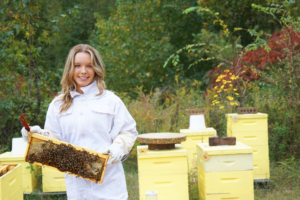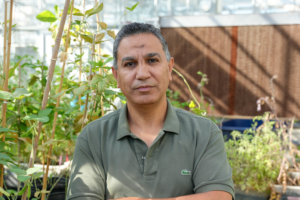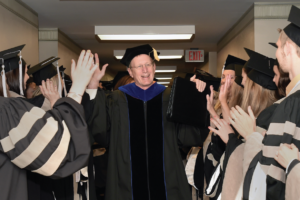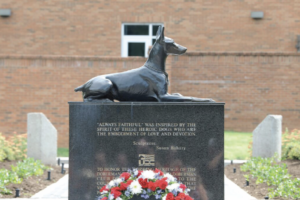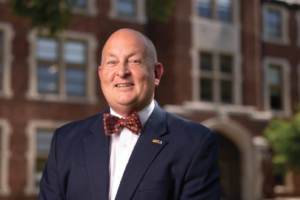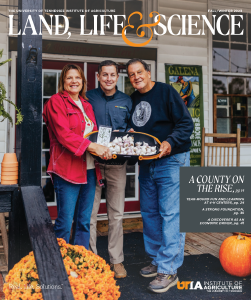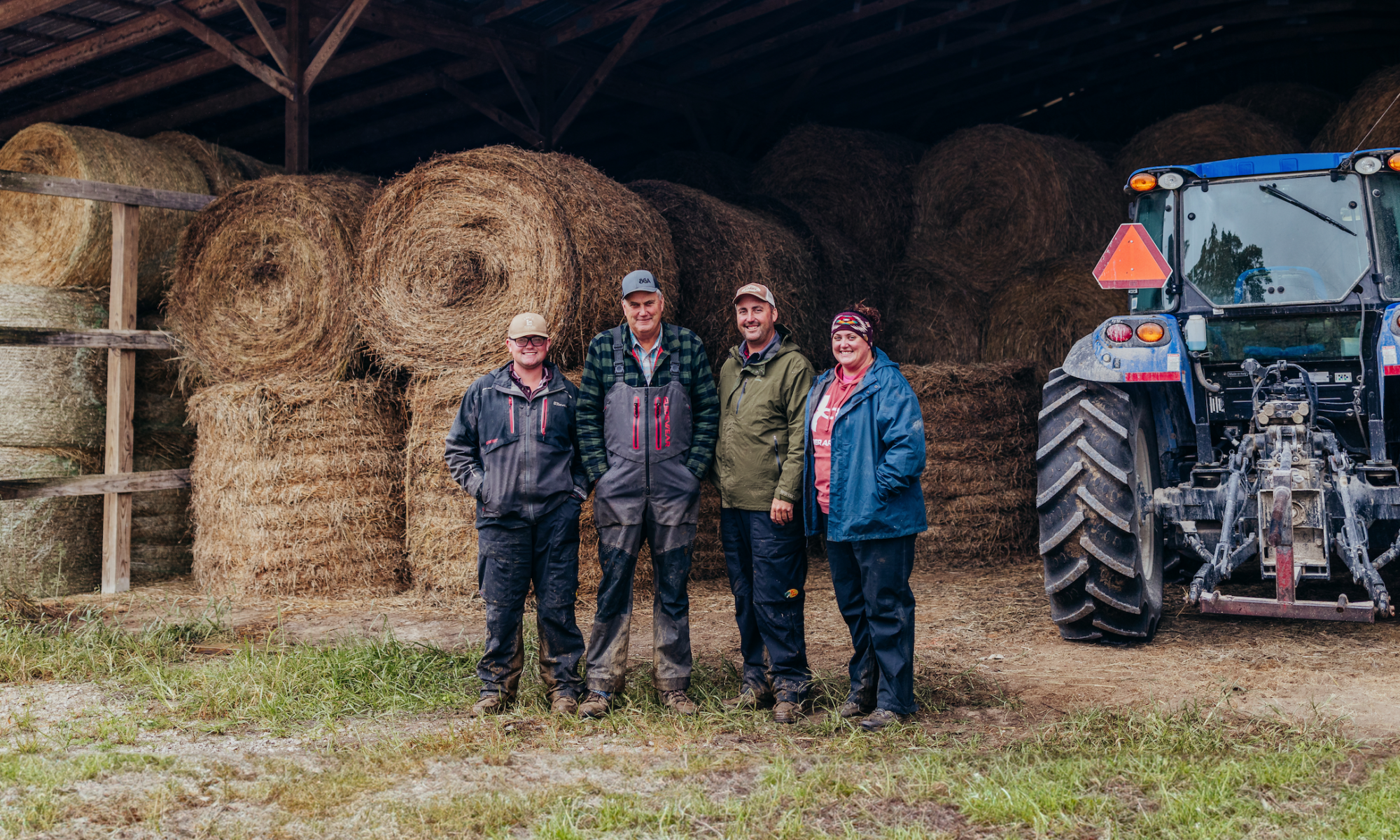
Like Lightning in a Bottle
A Convergence of Factors is Lifting the Rural County to Its Feet
The Neely family is one of Fentress County’s great successes in agriculture.
In their cattle backgrounding operation, three generations of the family are engaged in growing calves until they are ready to be sent to finishing farms in the Midwest. In a typical spring, the Neelys turn out 4,800 to 6,000 calves onto grass and grow hay on farms in the north and south end of the county, as well as at the county’s center—6,500 acres in all.
Ricky Neely has been raising cattle since the late 1970s. Under his leadership, the family has weathered drought, economic issues, and fluid markets to reach their current operation. He says UT Extension has always been there to assist them.
Son John Neely explains, “We use information from our UT Extension forage testing to determine which hay to feed certain groups of cattle, and (Extension agent) John Gunter comes out to help take samples and interpret results. We are in the grass business. We have to maintain pastures and that includes spraying. I can call John and know what to spray and when to spray. We also use them to identify pests or diseases. Extension has been a big help for quality information and assistance.”
If the Neelys’ ongoing success captures the strength of agriculture in Fentress County, it also reflects a challenge for this rural region. Successful family farms pass from one generation to the next, while land prices continue to increase, driven by scarcity and also an influx of new residents hailing from other states.
An estimated 70 percent of community members—the ones who work outside of agriculture—commute to jobs, south to Crossville or southwest to Cookeville, some thirty minutes away. Fentress County youth who grow up outside of large farms have to find ways to carve out a living, or commute … or leave. At least, that has been the thinking.
Gunter, director of UT Extension Fentress County, sees opportunities. New types of agricultural jobs are opening up in the county through technology and growth in agriculture-connected services and industries, and they are among a convergence of factors that is lifting this once economically distressed county to its feet.
A new superhighway from Clarkrange to Crossville is driving commercial development along the county’s southern area and shortening commute times to ten minutes for residents who travel for their jobs. UT Medical Center has returned an emergency care facility to the community after four years without one, and agricultural operations are booming, from cattle production and agritourism to farmers markets and community-supported agriculture shares.
All of the developments are great for the county, and so is a strong relationship between local government and Extension, a partnership dedicated to improving the lives of residents and investing in the future of the community: its youth.
Those aims align with two of Tennessee’s Grand Challenges, challenges that the UT System is working hard to address. The first is to strengthen rural communities, in part through improving their economic stability and preserving their cultural heritage. The second challenge is to advance K-12 education with emphasis on workforce and social development.
The clearest symbol of the thriving Extension-Fentress government partnership is a sleek, new black and hunter-green building sited in Jamestown along York Highway, one of the county’s busiest thoroughfares. The 11,280-square-foot facility opened in 2023 as the new home for Extension in Fentress County and also an agricultural pavilion—the very first for a county that sees more than $114 million in annual direct sales from agriculture.
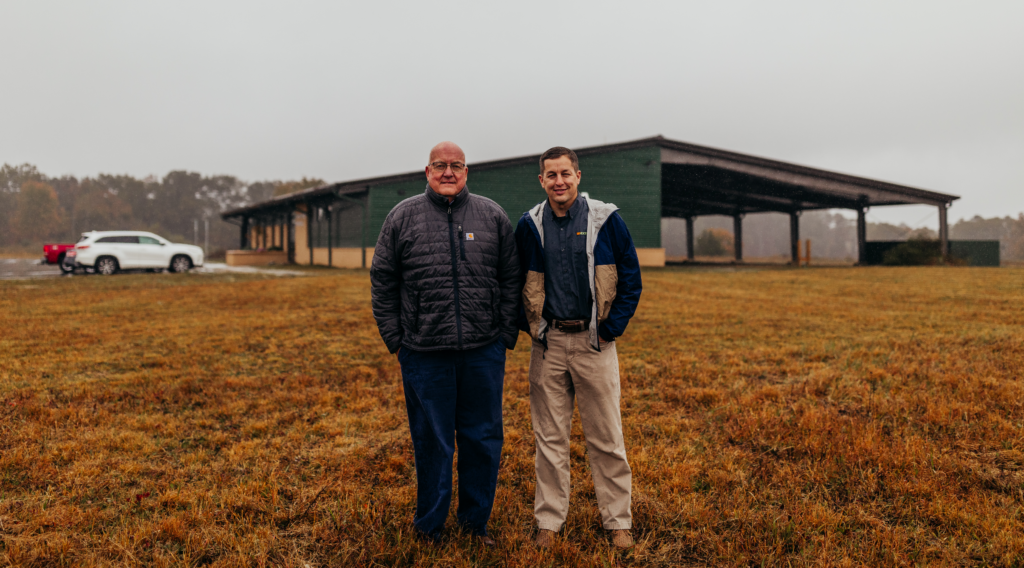
“The new facilities are an investment in the people of Fentress County, and particularly in our youth,” says county executive Jimmy Johnson. “To us, this building’s all about our future. The education that will take place here will change lives.”
Finding the right spot for the structure was paramount to Johnson and the county commissioners. They passed over an available plot of land upon learning that only 200 vehicles are estimated to pass by a day. Instead, the county government chose to purchase fifteen acres from a land company so the complex could be sited in a central location that is easy to access by all residents of the county.
“We have 8,000 eyes on this building a day,” Johnson says with satisfaction. “This is the front porch for our community.”
Gunter says Extension’s work to change lives is happening at a quickened pace due to the high visibility location and, also, as news spreads of the successes Extension has had in the county. One was in fielding the state championship 4-H livestock judging team, the county’s first since 1967.
“We’ve had more contacts, more calls, and more people stopping by than ever before,” he says. “We’ve also been able to host the state’s largest single-county Master Farm Manager certificate training thanks to the capacity of our new conference room. We had seventy-eight producers take part in the eight-session program.”
Extension has used its new space to host youth sessions on workforce development and ethical decision making, a college prep night, job fairs for 4-H’ers and other youth, and training for teachers on the UT Extension Family and Consumer Sciences’ On My Own curriculum, which prepares youth to manage their personal finances when they become adults.
Gunter says in these and other endeavors, “We are taking Extension’s research-based information and mingling it with the sound knowledge base that our people here already have, and it’s a great combination.”
John Gunter, UT Extension Fentress County Director
Another significant boost is that the Extension office is fully staffed now, due to Governor Bill Lee and the Tennessee General Assembly. In 2021, the legislature approved Lee’s line item to invest an additional $2.2 million in funding for UT Extension. The funds were earmarked to fully staff Extension offices in thirty-two Tennessee counties classified as “distressed” by the Appalachian Regional Commission. In Fentress, as well as the other counties, the funding enabled the addition, or reassignment, of an agent whose full focus is on 4-H and Youth Development.
There are more than 1,200 4-H’ers in Fentress County. That’s almost ten percent of the population, and the full-time 4-H agent is able to offer more opportunities to the youth in more diverse areas. Gunter says youth who once struggled to find a future in Fentress County have new opportunities because of the changes the county is experiencing.
“The kids are seeing a lot of people coming here wanting to homestead. We have tons of farmers markets and several community-supported agriculture operations now. Pasture-raised beef is huge. People finishing cattle here realize $3,000 to $4,000 a head. We do programming that helps our youth understand that there’s a need for a business understanding and perspective to these operations. That if they don’t go into them directly, they could work for the Farm Bureau or Farm Credit, or in feed. If they understand how GPS works, they can program a tractor to be precise in fertilizer or pesticide application, or make money flying drones over fields. I tell them, ‘Yes, you can pursue the new jobs in the agricultural field, ranging from precision agriculture to genomics.’ They can see that now.”
The county Extension staff is committed to delivering research-based information on all the things residents are doing or have interest in, from developing sound business plans and exploring markets to learning sewing and how to prepare easy, nutritious meals. “If Extension can introduce people to different perspectives and new ways of doing things, then that can open up opportunities for them,” Gunter says.
Extension’s efforts in these areas are receiving substantial assistance from two pairs of local change agents. Each husband-and-wife team is dedicated to sharing ideas that expand horizons for Fentress residents, and they are having impacts in highly innovative ways.
Meet a pair of garlic enthusiasts who are first-generation farmers and founders of a gourmet food chain, and a couple of local entrepreneurs who transformed a school’s modest proposal for $500 in funding into a $12,000 benefit pheasant hunt that provided 150 rural students with hands-on learning, exposure to an array of natural-resource professions, and a VIP-led career and outdoor sports fair.
A Speciality Crop With A Lot of Potential For Tennessee
First-generation farmer Laszló Marton tried growing garlic at the suggestion of his Hungarian mother. His success at it grew into a new livelihood. In addition to farming garlic on land in Illinois and Fentress County, he and his wife Debbie founded a gourmet food company named Galena Garlic that has grown to involve all three of their children, Nina, Maria, and Laszló, storefronts in three states, and a thriving mail-order business.
Laszló grows 6,000 to 8,000 pounds of garlic a year, much of which he sells wholesale. He also brokers garlic for others. He wants to help more people grow garlic, too, either for their own use or for commercial sale. The market is ripe for it.
The US imports some 199 million pounds of garlic a year. Domestic production accounts for only about 8 percent of what the US uses, and US-grown garlic sells in the range of $10 to $12 a pound, and even higher. “Today when you look online, you can find some domestic garlic being sold for $18 a half pound,” Laszló says. “It’s incredible.”
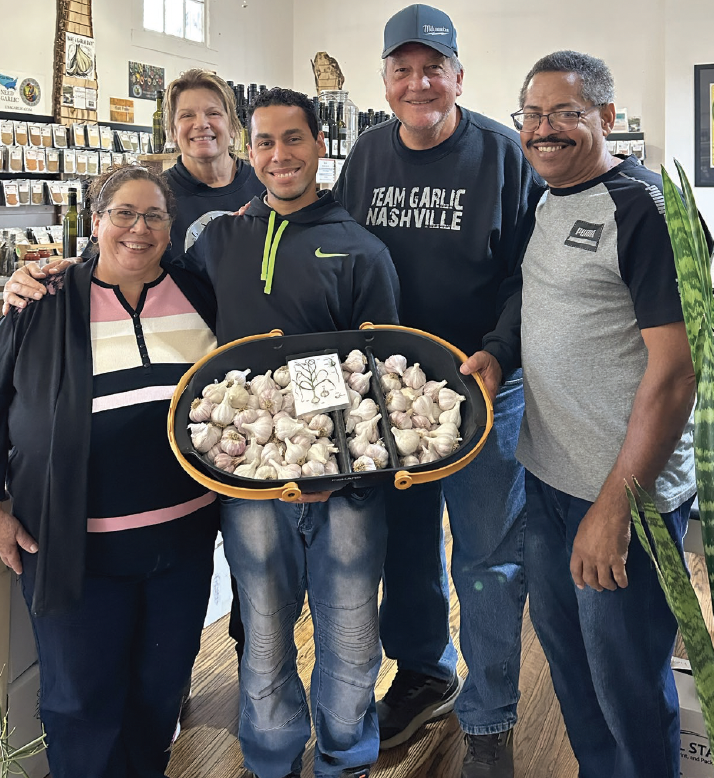
Fentress’s location in the northern Upper Cumberland region is close to ideal to grow the crop, and much of the state is suitable to produce garlic.
As a newcomer to Tennessee in 2019, Laszló found his way to the county Extension office, first for advice, then to enroll in Extension gardening classes. One contact led to another, and in 2023, the Center for Profitable Agriculture, a partnership program of UT Extension and the Tennessee Farm Bureau Federation, profiled Laszló’s garlic production to showcase a promising specialty crop for Tennessee.
In 2024, Laszló and the center are partnering again, this time on education-focused garlic festivals scheduled for July 26 in Jamestown, August 23 in Blountville, and September 13 in Memphis. Contact the center at cpa@tennessee.edu for more information.
As Laszló helps to pioneer a new crop for Tennesseans, he and Debbie are also expanding residents’ palates to ways to cook with garlic and use the specialty olive oils and spices that Galena Garlic sells. The Martons opened up a Galena Garlic storefront in Fentress County in early 2023. There, the couple holds cooking demonstrations and also hosts others who give demonstrations. A recent one taught how to grow microgreens. Their shop is a repurposed old schoolhouse that sits beside Highway 127 in Grimsley, Tennessee. The building has quickly grown into a community center. Farmers and crafters sell their goods on Saturdays. Yoga classes take place on a deck the Martons added out back, and they built an outdoor pavilion to host area gatherings.
There is no question that Laszló and Debbie are having an impact in the county. Their enthusiasm is infectious, and through his passion for garlic, Laszló commands attention for this promising specialty crop.
Helping Youth Think Big
Fred (DVM ’99) and Rhonda Moody grew up in the Upper Cumberland region. “It was a big leap to come to UT to study,” she says, and he adds, “It was for me, too.”
The two are a power couple in Fentress County. Fred commutes to Cookeville to the veterinary practice where he works. Rhonda is an insurance producer. Together they own Highland Manor Winery, the oldest winery in the state, in operation now for four decades. The couple launched Sawbriar Hunting Lodge in 2007. The lodge is the first wingshooting venue in Tennessee to land a prestigious endorsement by Orvis. They also operate Sawbriar Brewing tap room and Sawbriar Gun Dogs Kennel specializing in British Labradors.
Those are more than enough demands to hold the Moodys’ attention, yet they remain aware of the challenges youth in this isolated area face in finding their futures, and they want to do something about it. “Youth grow up here, and they know they need to earn a college degree but then they don’t know what to do with it,” Rhonda says. “They need assistance in connecting their interests to viable careers. That if natural resources interests them, yes, they can work for TWRA (Tennessee Wildlife Resources Agency), and they also can find opportunity as a natural resource manager in Colorado or as a nature guide in Alaska. They need help thinking big.”
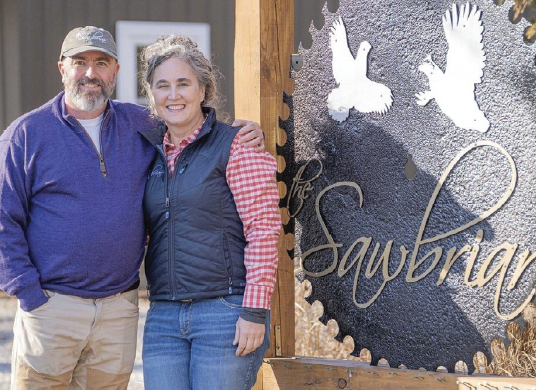

A way to nudge youth into thinking big is to connect them to degree concentrations and career options in the Herbert College of Agriculture. Fred says, “Whether it’s bringing Herbert recruiters and Herbert students here to meet with our local youth or taking teachers and the principal of York Agricultural Institute to meet with the Herbert dean and department heads, we want Herbert academic units and majors to become associated with faces and names, and not just a post on Instagram.”
Last year, a special opportunity arose to raise youth’s awareness of Herbert study paths. Fred is a graduate of York, Tennessee’s only state-operated vocational high school and one whose mission to serve the area’s rural families and youth goes straight back to famed World War I marksman, Sgt. Alvin C. York, a son of this county who wanted to bring opportunities to its residents. York Institute is named in his honor.
In the past few years, Fred has witnessed a resurgence of teaching agriculture at the institute, one that includes York students raising twelve different crops and livestock on the school’s eighty-acre farm. Potential exists to sell their goods to bring in revenue and possibly fund scholarships for the students. To that end, Extension specialist Rachel Painter and the Center for Profitable Agriculture, Gunter, and the Moodys have been in discussions with York on developing a business plan to market and sell the commodities and value-added products.
When a York teacher approached Fred with the idea that students raise pheasants to sell to Sawbriar Hunting Lodge, Fred ran the numbers in his head. “If I bought pheasants from York, that would only net them about $500 at best,” he says. “I found myself thinking what if, instead, I involve the students and the food they grow in a benefit hunt day? The whole event could be a fundraiser for them, bring in far more money, and also show the students career opportunities in hospitality and as nature guides.”
And that’s just what happened on October 27, 2023, when the Moodys hosted the Feather to Fork Benefit Hunt Day. Thirty students in York’s agriculture program participated in working aspects of the lodge. They were able to hunt and shoot clays and participate in the hospitality portion of the business. An additional 120 York students came to see displays and take part in a career and industry fair where close to twenty vendors and sponsors provided youth with information about different college degrees and natural resource fields. Students saw drones capable of spraying fields and ponds, tried their hands at fly fishing, and learned safe and responsible hunting practices.
UTIA Senior Vice Chancellor and Senior Vice President Keith Carver and representatives of Herbert College of Agriculture were there, as were area legislators, heads of several state agriculture and conservation agencies, and representatives of outdoor sporting businesses, including Orvis.
Fred says special thanks goes to Eye Centers of Tennessee, “They jumped head first into the cold, murky waters of an unknown fundraiser and contributed start-up funding that made Feather to Fork possible and to keep it going.” He and Rhonda intend to build upon this event’s success for an even better Feather to Fork benefit hunt in 2024.
Fentress County was classified as a distressed county from 2002 to 2021, when it moved into the less critical category of “at risk.” Gunter and Johnson think Fentress will soon leave the list of Tennessee threatened counties entirely. The forward momentum is supported by growth in services and jobs from agriculture, the local government’s investment in Extension, and changemakers like the Martons and Moodys. Together, they promise a bright future for Fentress County and its residents.
Explore More on
Cover Articles
MORE FROM THIS ISSUE
